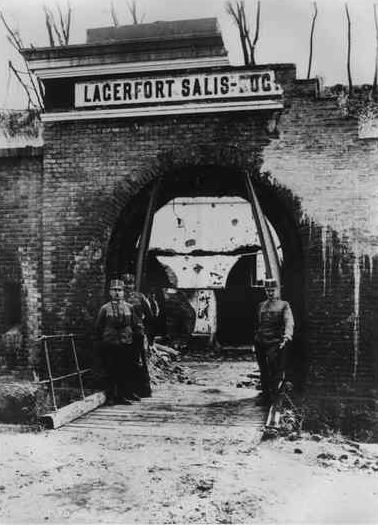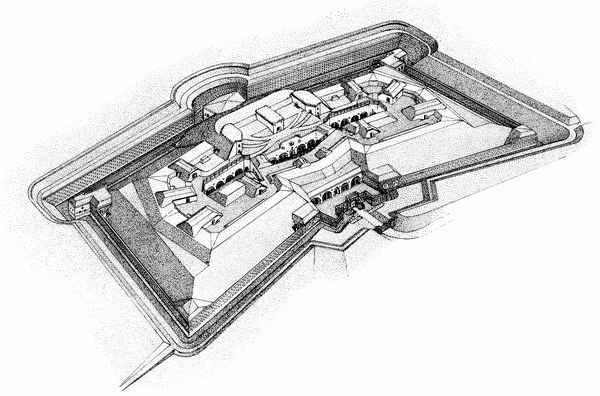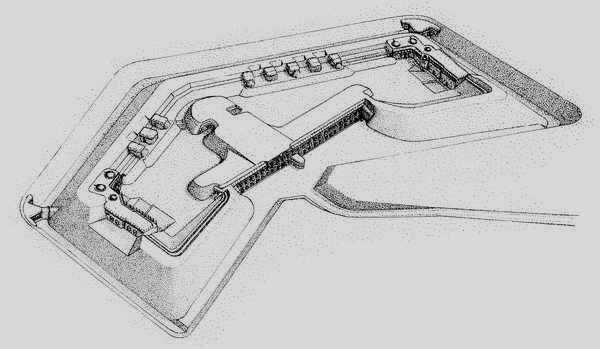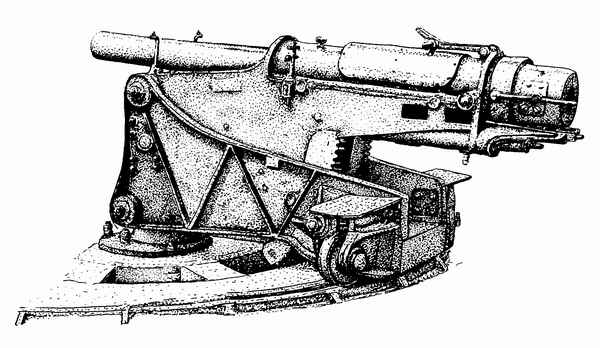The History of the Construction of the Fortress of Przemyśl
By Tom
Idzikowski
 On
the day of the outbreak of the First World War the fortress of Przemyśl consisted
of varied fortification complexes from different periods of time.
Beginning with the obsolete artillery entrenchments from the mid-19th
century, throughout artillery forts from the 1880s, to modern armoured forts
from the turn of the 19th century. This was the result of a long
duration of the construction of the fortress as well as the development of
technology and engineering during that period and consequent modification of the
art.of fortifications
On
the day of the outbreak of the First World War the fortress of Przemyśl consisted
of varied fortification complexes from different periods of time.
Beginning with the obsolete artillery entrenchments from the mid-19th
century, throughout artillery forts from the 1880s, to modern armoured forts
from the turn of the 19th century. This was the result of a long
duration of the construction of the fortress as well as the development of
technology and engineering during that period and consequent modification of the
art.of fortifications
The first plan of having Przemyśl fortified took place at the
beginning of the 19th century. Since 1810 different ideas of
fortifying the San crossing had been introduced. While thinking about taking
advantage of the city walls, the project of creating a small, ring-shaped
fortresses and an entrenched camp was considered.
Due to friendly relationships between Austria and Russia none of the
projects had been started until 1854. The year 1854 is considered as the
beginning of the construction of the Fortress of Przemyśl.
With regard to the Crimean War the mutual relations between Austria and
Russia progressively worsened so that the Austrians started constructing the heptagonal artillery
entrenchments around Przemyśl. 41 entrenchments had been planned, 19
completed, 9 works were under construction and 13 had not been commenced, since
in 1855 the mutual relationships between Austria and Russia improved again .
From 1855 to 1878 a 23 year break in the construction of the fortress
occurred. In that period a number of projects of fortifying Przemyśl had been
introduced, however due to good relations with the Russians, the Austrians did
not carry any of them into effect. Until 1878 several magazines and barracks as
well as roads leading to the planned sites of the forts had been completed. The
Bosnian Crisis in 1878 caused a restarting of the fortification work – 9 earth
forts were completed.
The starting point of constructing solid forts is considered as 1881. This
year is therefore thought as the real beginning of the construction of the
Przemyśl Fortress. Mainly artillery forts had been raised until 1886.
Single-rampart forts (V Grochowce, VII Pralkowce, VIII Letownia, XII Werner)
were completed first plus a non typical I Salis Soglio. In the same
time three double rampart artillery forts (X Orzechowce, XI Dunkowiczki, XIV
Hurko) were constructed.
After 1890 new types of forts – small infantry forts located in the
middle ground of the main forts had appeared (IIb Cykow, Va Lesniczowka Grochowce,
VIIIa Lesniczowka Letownia, XIIIa Zablocie) as well as small armoured forts (I/1
Lysiczka, I/2 Bykow, I/5 Popowice, I/6 Dziewieczyce, VII1/2 Tarnawce, IXa Przy
Krzyzu, Xa Pruchnicka Droga, XIa Cegielnia, XV Borek). In the 1890s the main
armoured forts had been constructed (IV Optyn, IX Brunner, XIII San Rideau) and
existing double rampart artillery forts were transformed into armoured forts for
close defense (X Orzechowce, XI Dunkowiczki).
Following
the turn of the century
the constructions and modifications which had been started
earlier were being completed. Budget cutting caused suspension of the extensions
of the fortress. After 1910 some small work on the field fortifications was continued
(probably the infantry strong points “Orzechowce” and “Pruchnicka Droga”
had been completed).
 The last stage of construction of the fortress took place in 1914, just
after the outbreak of war. Field fortification amongst the forts had been
developed (a great number of infantry strong points, continuous lines of
trenches in the middle ground, field artillery batteries, field barracks
complexes) as well as in the distant foreground (e.q. The Helicha Group, Pod
Mazurami, Batycze, Na Gorach). The work was also continued during both
sieges of Przemyśl.
The last stage of construction of the fortress took place in 1914, just
after the outbreak of war. Field fortification amongst the forts had been
developed (a great number of infantry strong points, continuous lines of
trenches in the middle ground, field artillery batteries, field barracks
complexes) as well as in the distant foreground (e.q. The Helicha Group, Pod
Mazurami, Batycze, Na Gorach). The work was also continued during both
sieges of Przemyśl.
After being recaptured in June 1915 the fortress lost its rank, it had
been degraded to the rank of a bridgehead. The latter point resulted in several defense
works which had been destroyed during the fighting and as result of the capitulation
were then reconstructed, especially those which were located on the right bank
of the River San. A Developed field fortification complex was built on the distant
foreground of the forts located on the right bank of the San. They formed the
front defense line of the bridgehead.
In the years 1940-41 a part of the Przemyśl fortification was used by the
Russians who were then constructing the Molotov Line.
The process of the creation of Fortress of Przemyśl consisteded of several
stages which caused the appearance of various defensive objects which makes the
fortress one of the most interesting of it's type across the whole of Europe. The
additional attraction of the forts of Przemyśl is their low degree of
standardization in comparison to other fortresses.
Despite vast destruction done to the fortress after its surrender,
between the two World Wars and after the second World War, the fortress has become
the constant component of the landscape of Przemyśl. While visiting Przemyśl,
the fortress cannot be missed.
THE
FIGHTING FOR THE FORTRESS OF PRZEMYŚ'L
The garrison of the Fortress of Przemyśl on the first day of
mobilization, 31 July 1914, was not numerous (quite inconspicuous). Its
commander had only at his disposal five battalions of infantry, a troop of field
artillery, three regiments of fortress artillery and a number of companies of
sappers. The other units quartered in Przemyśl were ordered to execute covering
activities (to go up the line) away from the fortress.
 During the mobilization the garrison increased, however some units
had also to go up the line. On 2nd August the preparation for the defense of the
fortress began – the field fortifications were under construction. The
foreground of the fortress had been cleared since September, 2 (the forests were
cut down and the buildings were pulled down). On September, 4 the headquarters
ordered the civilians who were not supplied with food for three months to
evacuate.
During the mobilization the garrison increased, however some units
had also to go up the line. On 2nd August the preparation for the defense of the
fortress began – the field fortifications were under construction. The
foreground of the fortress had been cleared since September, 2 (the forests were
cut down and the buildings were pulled down). On September, 4 the headquarters
ordered the civilians who were not supplied with food for three months to
evacuate.
On the 15th of September the High Command of Austro-Hungarian Army left
Przemyśl. The Russians attacked Jaroslaw and Sieniawa on 16 September. The very
first shot was fired towards the Russian Cavalry patrol seen near Tyszkowice on
September 17 1914 from fort I/5 Popowice. 17th of September is therefore
considered as the beginning of the first siege of Przemyśl. On 20 September the
Russians crossed the River San. The next day there was a counterattack from the
fortress in the direction of Radymno. Due to this the garrison of Radymno and a part
of the Jaroslaw garrison were rescued.
On 26 September the Russians surrounded Przemyśl completely cutting
off 131 thousand people and 21 thousand horses.
On October 4, an officer with a flag of truce appeared bringing the
proposal of capitulation. The Austrians did not accept the proposal. Since
October 5 the Russians had begun desultory bombarding the forts. Simultaneously
the infantry troops approached the forts. On October 6 the bombardment was
intensified and the infantry approached within 500 metres of the forts. The circumferential
assault began at 3.00 a.m. on 7th October. During this day the
strongest Russian attack was against fort I/1 Lysiczka. The Russians managed
to break in but after a while their troops were invested (surrounded) by the
Austrian units who forced them to surrender.
Forts XIV Hurko, XV Borek, I/2 to I/6 and IV Optyn suffered strong
attacks. Excluding fort I/1 the Russian assault was unsuccessful. They did not
manage to capture any other fort. The Russians suffered considerable losses – a
total number of 10,000 personnel (3,000 – 4,000 killed in action, the rest
wounded and captured by the Austrians).
On the following day, October 8, the Russian Army commander, General
Radko Dymitriew ordered another assault, this time towards the northern sector
of the fortress. Forts Xa Pruchnicka Droga, XIa Cegielnia, XI Dunkowiczki and
XII Zurawica were attacked but the Russians were unable even to reach the
wire entanglements in front of the forts.
The relief to the besieged fortress came on October 9, and the Russian troops
were driven back behind the River San. The front had been established at the
foreground of the forts at the eastern section of the fortress and along
Medyka-Pleszowice-Tyszkowice-Gora Magiera line. The first siege was over and
soon after that the High Command decided that the field army troops should use
the provisions of the fortress.
Considering the threat of being outflanked the Austria-Hungarian armies
had to withdraw from the River San line. The last frontline units withdrew from Przemyśl
during the night of 4th and 5th November. The renewed seclusion (locking) of the
fortress took place on 8th November. The decision had been made that the defense
should contain the enemy offensive elements in order to tie down as many Russian
forces as possible. In the period between the sieges an additional defense
line, in the foreground of the forts had been developed. These appeared particularly
before the forts VI Helicha and VII Pralkowce (Helicha and Pod Mazurami fortified
positions) as well as along the northern section (Batycze and Na Gorach
fortified positions).
 During the second siege the Russians did not try to assault against the
fortress. Numerous sallies (sorties) had been taken (run) from Przemyśl towards
the foregrounds. The biggest of them took place on 14th and 20th November. They were
directed to the west toward Bircza, Posada Rybotycka, Rybotycze, Wola
Rokietnicka and Kosienice. There were several efforts to join the
Austria-Hungarian Armies which had been launching an offensive in the region of
Sanok.
During the second siege the Russians did not try to assault against the
fortress. Numerous sallies (sorties) had been taken (run) from Przemyśl towards
the foregrounds. The biggest of them took place on 14th and 20th November. They were
directed to the west toward Bircza, Posada Rybotycka, Rybotycze, Wola
Rokietnicka and Kosienice. There were several efforts to join the
Austria-Hungarian Armies which had been launching an offensive in the region of
Sanok.
On November 28, the Russians attacked the Batycze and Na Gorach fortified
positions. Two days later the Austria-Hungarian forces counterattacked in the
same direction. The next sallies (sorties) took place on 9th, 10th, 13th, 15th-18th
December. On the last day the Russians captured the Na Gorach fortified
positions. On the 20th, 21st , 22nd December Austrian counterattacks did not succeed. The
last sortie come out of the fortress on the 27th-28th December 1914. At the same time
the offensive in the region of Sanok was discontinued due to its inefficacy.
Between 19th December 1914 and 5th February 1915 there was no consecutive
fighting. The bled Austria-Hungarian forces were not capable of further offensive
activity. Food and maintenance became a problem. The provisions in the magazines
which had been used by the field armies during their withdrawal before the second
siege had run out. The soldiers had to be put on short rations, 13,000 horses
had to be slaughtered to feed the army.
Since 9th February 1915 the Russians began to suppress the advanced
Austrian positions. The fortified positions Na Gorach and Batycze had suffered a
strong assault. Despite some counterattacks from the fortress, on March 14, the
advanced positions of the northern sector had been completely liquidated. The
Russians also attempted to capture the field positions in the west of Przemyśl
amongst other objectives on 19th February 1915 without success.
The situation of the besieged forces was getting critical, the food was
running out, the besiegers' ring was tightening, the hospitals were overcrowded with
the wounded and ill soldiers. Not only the morale of the common soldiers had gotten
low but also that of the officers’. The General Commanding, General der
Infanterie Kusmanek was conscious of
the possible mutiny and the consequent surrender of the fortress despite its
fighting readiness. That is why in March he came to the decision to break out together with the fortress
garrison towards the field armies. Initially he had
planned the assault in the direction of Sambor but then having considered the
situation at the front and the easier terrain for a forced march he had chosen the Grodek
Jagiellonski bearings. During the night of 18th and 19th March the forces which had
been assigned for the assault were concentrated. Constantly falling rain and
snow as well as the exhaustion of the soldiers considerably slowed the the progress of the
concentration. The assault kicked off at dawn. The enemy
couldn’t have been taken by surprise. They only managed to capture the
advanced Russian positions. The attack got stuck along the main defense
line after having been heavily bombarded by the Russian artillery. Then began
the Russian counterattack that caused Austrian-Hungarian forces to withdraw.
Eventually the breakout attempt ended at 2 p.m. with the last soldier
withdrawing back to the fortress. No more attempts to breakout were attempted
On 19th March they began to burn the documents and banknotes. The vehicles,
telephones and telegraphic apparatus were destroyed on 21st March, and all the
horses that had survived were slaughtered. On 22nd March, between 5.00 and 5.30
a.m. the artillery pieces were blown up, and at 6.00 a.m. the forts, bridges
and other military facilities shared their fate. Three hours later the first
Russian troops marched into Przemyśl. 9 generals, 93 field officers,
2,500 lower ranking officers and 117,000 NCOs and private soldiers were taken
prisoner.
The Russians began to adapt the demolished forts to be useful for
defensive purposes. The blown up shelters were provisionally strengthened
with pieces of wood, the embankments (ramparts) had been supplemented with sandbags.
T the Russian artillery provided the forts with arms and the
obstacles were renewed with barbed wire. Despite their provisional state all
efforts were made to renew the defensive capacity of the fortifications.
The Russian Tsar (Czar) Nikolaus visited the Fortress of Przemyśl on 25th
April 1915 drawing his attention to the destroyed forts, particularly to those
which were responsible for the most intensive fighting during the first siege.
On 15th May 1915 the war returned to the region of Przemyśl. The units of
the 10th corps approached the fortress from the southwest. They had
been ordered to capture Przemyśl with a sudden assault. During the night of
16/17th May they reached the entanglements of fort VII Pralkowce but the
resistance of the Russians stopped the attack. The Austria-Hungarian forces had
to withdraw. The consecutive assault was launched on 30 May. Fort VII Pralkowce
had been successfully captured but the Russian counterattack and the bombardment
compelled the Austrians to leave the defensive works.
Between 30th May and 2nd June the German units supported by the heavy 420-mm
mortar bombardment succeeded in capturing the forts on the left bank of the
River San. The Russian forces having been afraid of the prospect of a siege began a
gradual withdraw from Przemyśl. On 3rd June 1915 the Austria-Hungarian and German
forces entered Przemyśl. The last forts were recaptured on 5th June 1915.
After it's recapture, the Fortress of Przemyśl was renamed as a
bridgehead. The first line of defense covered the front line from the
period between the two sieges, the second defense line was based on the forts
situated on the right bank of the River San. Some provisional repairs of the
forts were carried out but until the end of war they were not used again in the
fighting.
The forts were put to military use again during the Polish-Ukrainian war
during the 1920s and very marginally in the period of the Second World War.
Text and Images copyright Tom Idzikowski
Back to Engagements and Battles

 On
the day of the outbreak of the First World War the fortress of Przemyśl consisted
of varied fortification complexes from different periods of time.
Beginning with the obsolete artillery entrenchments from the mid-19th
century, throughout artillery forts from the 1880s, to modern armoured forts
from the turn of the 19th century. This was the result of a long
duration of the construction of the fortress as well as the development of
technology and engineering during that period and consequent modification of the
art.
On
the day of the outbreak of the First World War the fortress of Przemyśl consisted
of varied fortification complexes from different periods of time.
Beginning with the obsolete artillery entrenchments from the mid-19th
century, throughout artillery forts from the 1880s, to modern armoured forts
from the turn of the 19th century. This was the result of a long
duration of the construction of the fortress as well as the development of
technology and engineering during that period and consequent modification of the
art.